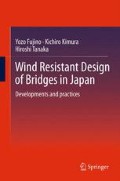Abstract
Structural damping of bridges needs to be specified in a wind resistant design code for examining their dynamic behavior against anticipated wind action. Because the dynamic response of bridges is generally evaluated by using the modal analysis, the quantity of structural damping has to be represented in terms of modal damping. The damping specification in the design code, therefore, is given in modal damping, based on the results of field measurements. The design and construction of long span bridges, such as Honshu-Shikoku bridges, have been continuously going on in Japan since 1970s. The modal damping data of long span bridges have been accumulated throughout this period by conducting field vibration tests, often just after completion of their construction, in order to verify the design assumption against the reality. At the same time, the modal damping data of medium span bridges have been also measured and accumulated by field vibration tests, since the field measurements are not only for the wind resistant design but also for the consideration of vehicle-induced dynamic responses. The structural damping values in logarithmic decrement are specified in wind resistant design codes by referring to these measured data, with the addition of some engineering judgments, since the theoretical evaluation of structural damping is very difficult at present.
Access this chapter
Tax calculation will be finalised at checkout
Purchases are for personal use only
References
Ito M, Yamaguchi H (1995) Full-scale measurements and structural damping of cable-supported bridges. In: Proceedings of the international bridge conference, Hong Kong, pp 557–564
Okauchi I, Miyata T, Tatsumi M, Kiyota R (1992) Dynamic field tests and studies on vibration characteristics of long-span suspension bridges. Struct Eng/Earthquake Eng JSCE 9(1):89s–100s
Narita N, Yokoyama K (1991) A summarized account of damping capacity and measures against wind action in cable-stayed bridges in Japan. In: Ito M, Fujino Y, Miyata T, Narita N (eds) Cable-stayed bridges. Elsevier, Amsterdam, pp 257–278
Abe M, Fujino Y (1999) Monitoring of long span suspension bridge by ambient vibration measurement. In: Proceedings of the 2nd international workshop on structural health monitoring
Abe M, Fujino Y, Nagayama T, Ikeda K (2003) Non-iterative identification of non-proportionally damped system from ambient vibration measurement and analysis of dynamic properties of a long-span bridge (in Japanese). J Struct Mech Earthquake Eng JSCE 745(1–65):155–169
Nagayama T, Abe M, Fujino Y, Ikeda K (2005) Structural identification of a nonproportionally damped system and its application to a full-scale suspension bridge. J Struct Eng ASCE 131(10):1536–1545
Yamaguchi H, Fujiwara T, Yamaguchi K, Matsumoto Y (2004) Coupling of cable vibration and its damping effect in long-span cable-stayed bridge: the Tatara bridge (in Japanese). J Struct Mech Earthquake Eng JSCE 766/I-68:309–323
Akiyama H (1988) Field vibration tests in Honshu-Shikoku bridge authority (in Japanese). Bridge Foundation Eng 88(8):139–140
Yamaguchi K, Manabe Y, Sasaki N, Morishita K (1999) Field observation and vibration test of the Tatara Bridge. In: Proceedings of the IABSE conference on cable-stayed bridges, Malmo
Nishioka N, Toriumi R, Oka K, Sasaki N (2000) Field vibration test of the Akinada Bridge (in Japanese). In: Proceedings of the 55th annual meeting of JSCE, I–B104, pp 208–209
Yamaguchi H, Takahashi M (1996) Damping analysis of cable-stayed bridges. In: Proceedings of the International conference on urban engineering in Asian cities in the 21st century, Bangkok, pp 343–348
Yamaguchi H, Ito M (1997) Mode-dependence of structural damping in cable-stayed bridges. J Wind Eng Ind Aerod 72:289–300
Fujiwara T, Tamakoshi T, Ueda T, Nanjo M, Kobayashi Y (1993) Characteristics of vibration of complex multi-cable stayed bridge (in Japanese). J Struct Eng JSCE 39A:831–839
Yamaguchi H, Takano H, Ogasawara M, Shimosato T, Kato M, Okada J (1997) Identification of dynamic characteristics of the Tsurumi Tsubasa bridge by field vibration tests. Struct Eng/Earthquake Eng JSCE 14(2):215s–228s
Yamaguchi H, Takano H, Ogasawara M, Shimosato T, Kato M, Kato H (1997) Energy-based damping evaluation of cable-stayed bridges and application to Tsurumi Tsubasa bridge. Struct Eng/Earthquake Eng JSCE 14(2):201s–213s
Yamaguchi H, Nishimura T, Tsutsumi K, Yamaguchi K (2001) Damping effect of coupled cable vibration in a cable-stayed bridge. In: Proceedings of the 4th international symposium on cable dynamics, Montreal, pp 153–160
Hagiwara M, Odagiri N, Takeuchi K, Ogaki K, Hirose K (1994) Field vibration test of the Rainbow Bridge (in Japanese). In: Proceedings of the 49th annual meeting of JSCE, I-585, pp 1168–1169
Honshu-Shikoku Bridge Authority and Bridge & Offshore Engineering Association (1985) Construction report on the Innoshima Bridge (in Japanese). 299 pp
Wada K, Koyama J, Takano H, Tsumura N, Hayashi H (1992) Vibration test of the Yokohama bay bridge (in Japanese). Bridge Foundation Eng 92(2):15–18
Okauchi I, Miyata T, Tatsumi M, Sasaki N (1997) Field vibration test of a long-span cable-stayed bridge using large exciters. Struct Eng/Earthquake Eng JSCE 14(1):83s–93s
Takahashi M, Nishimoto S, Hashimoto K, Tsumura N, Koike Y (1994) Active vibration control of Hakucho bridge tower under construction (in Japanese). J Struct Eng JSCE 40A:935–942
Metropolitan Expressway Public Corporation (1995) The Tsurumi Tsubasa bridge, technical report (in Japanese). MEPC, Tokyo
Metropolitan Expressway Public Corporation (1991) The Yokohama bay bridge, technical report (in Japanese). MEPC, Tokyo
Yamaguchi H (1994) Modal damping of cable structures and its theory (in Japanese). Steel Construct Eng JSSC 1(3):129–138
Japan Road Association (1991) Wind resistant design manual for highway bridges (in Japanese). Maruzen, Tokyo, pp 119–121
Japan Society of Civil Engineers (1985) Vibration handbook for civil engineers, JSCE, Tokyo (in Japanese)
Author information
Authors and Affiliations
Corresponding author
Rights and permissions
Copyright information
© 2012 Springer
About this chapter
Cite this chapter
Fujino, Y., Kimura, K., Tanaka, H. (2012). Structural Damping. In: Wind Resistant Design of Bridges in Japan. Springer, Tokyo. https://doi.org/10.1007/978-4-431-54046-5_5
Download citation
DOI: https://doi.org/10.1007/978-4-431-54046-5_5
Publisher Name: Springer, Tokyo
Print ISBN: 978-4-431-54045-8
Online ISBN: 978-4-431-54046-5
eBook Packages: EngineeringEngineering (R0)

